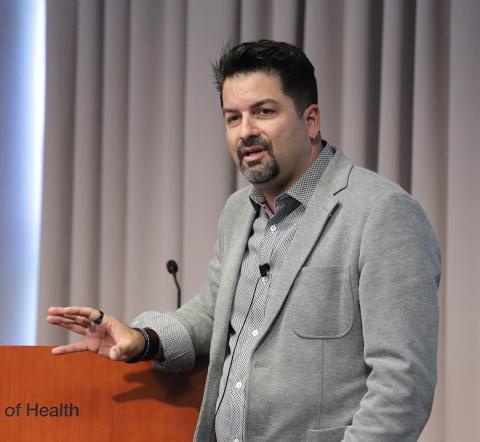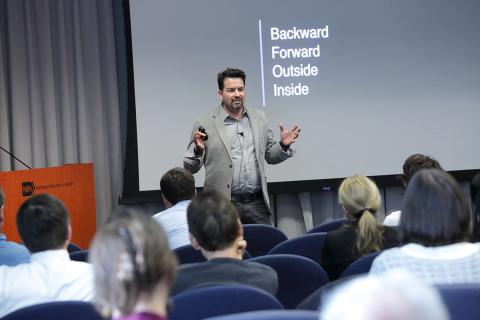Training in Mental Health
Olivet Aims to Speed Compassionate, Effective Intervention

Photo: Ernie Branson
There is a canard in health care about a 17-year gap between science and service, and between research and clinical practice. Jeff Olivet, CEO of the Center for Social Innovation (C4) in Needham, Mass., is determined to narrow that gap through the creative and compassionate application of new learning and teaching methods.
These approaches, which he described at an NIMH Director’s Innovation Speaker Series lecture on Nov. 10, take as their inspiration the technological savvy of online companies such as Zappos, which can deliver a new pair of shoes to your doorstep in pretty much the time it takes to think about it, and the social crusading of luminaries such as the 19th century mental health reformer Dorothea Dix.
Certainly one of the longest journeys between clinical insight and eventual therapy was the 2,500 years it took to eradicate smallpox, noted Olivet. In 479 BC, Thucydides recognized that smallpox survivors never got smallpox again. Centuries later, ancient Chinese practitioners also took note of the link between exposure and immunity, making a powder of smallpox scabs that were then blown into the nostrils of patients. Finally, the smallpox vaccine was introduced in England in 1796, and smallpox was eradicated from the planet in 1980.
Dorothea Dix, Olivet noted, was “a one-woman dissemination machine, who through the careful collection of data and a relentless focus on social change and equity” was able to inspire creation of more than 100 state mental hospitals in the U.S. between 1841 and 1881. These provided literal asylum from penal institutions, where many mentally ill inmates were treated inhumanely. “Research and advocacy are a powerful combination,” said Olivet, whose current work is inspired by Dix’s “deep, compassionate, human, connected ideas.” He is convinced that “if we bring open ears, creativity, heart and open eyes” to the stubborn problems of homelessness and mental illness in the U.S., much suffering can be alleviated.
Olivet and his team realize that “it’s not good enough just to have good information and push it out to the world. We need really great adult learning and we need to make it sticky. Beautiful design really matters. You get really awesome stuff when it’s all put together.”
Back in 2009, C4 took on the challenge of training a mental health workforce online. With support from NIMH, they developed an 8-week course called Critical Time Innovation (CTI), an online experience that merged insights from both traditional problem-based learning and communities of practice. Some of the class was with a live instructor, but most of it was self-paced learning, Olivet explained. A fictional character they dubbed “Michael” proved central to the learning process as he moved through a series of “choose your own adventure” simulations. The online CTI course was designed as an alternative to 2-day in-person training, which had been the previous standard, and resulted in better knowledge retention among students as well as dramatic cost savings--$2,700 per enrollee vs. $8,116 when it was first developed.

Photo: Ernie Branson
“We now combine the online training with personal coaching,” said Olivet, who reported that the online CTI course has been presented 12 times since 2013. Some 177 agencies have subscribed, involving about 900 trainees, and the cost is now down to about $542 per agency, or $108 to train a person on CTI. “We would like everybody to be doing CTI,” Olivet said, “and we believe online learning is a cost-effective, scalable way to support it.”
Another key mental health training module is motivational interviewing (MI). Here again, the standard training for years had been 2 days of classwork, followed by practice sessions. Olivet’s team developed a multi-faceted product suite that includes an MI simulation game. More than 1,000 people at some 270 agencies have trained on it so far. “The learning goes really deep,” said Olivet. “It beats a webinar, or just putting the information out there.”
Building on NIMH’s pioneering work on first-episode psychosis, Olivet and his team have recently launched a new project in partnership with NIMH and first-episode psychosis experts across the country to support dissemination of Coordinated Specialty Care (CSC). Borrowing filtering concepts from Zappos, the online CSC OnDemand tool allows users “to create their own pathway through the curriculum, which includes videos, podcasts, hand-outs, and case studies,” said Olivet. “There is a core set of modules as the starting point, then an almost infinite set of pathways through the material. We are moving to a learner-centric mode from a resource-centric mode. Our guiding principle is ‘You know what you need.’”
In addition to these high-tech curricula, Olivet and his team have also experimented with video games for young adults with psychosis. They have found that it is important to a person who has had psychosis to be able to pick such things as shoes and a look for his or her avatar. “The game is not about illness or treatment,” he continued, “but about integration of recovery into life. Basically, you live your life, and you learn about yourself, your connection to others and recovery.”
Olivet said patients also need to hear from other people in recovery. “It’s critical for finding hope and inspiration.” Video testimony from recovering patients, which is part of the game suite, is “empowering, hopeful and grounding.”
Olivet acknowledges that his center’s freshest tools for young patients can play a role in fostering hope, recovery attitudes, empowerment and overcoming stigma. “We are finding that integrating the voice of lived experience is crucial,” said Olivet, who includes on his staff many who are in recovery. “People with lived experience have transformed the fabric of our organization,” he said. “They have sharpened the lenses we bring to our products…People are more than their labels.”
Olivet finished his talk with a brief description of a study he began in the fall of 2016 on why people of color are overrepresented among the homeless population. “That is a disparity that is under-studied,” he said. The 1-year mixed-methods study will examine 10 communities. “The voices of people of color who have been homeless will guide the way.”
He concluded, “Science plus technology plus story equals real change on a large scale.” He urged NIH, which provides much of the grant money for these studies, to “dig deep and stay focused. We need you more than ever. It’s incredible, the work you do. It’s changing things. What you do matters. You are improving the lives of people who have suffered deeply. And the need is more critical now than it has ever been.”
